|
|

This chapter describes how to configure DLSw+, our implementation of the data-link switching (DLSw) standard for Systems Network Architecture (SNA) devices. For a complete description of the commands in this chapter, refer to the "DLSw+ Configuration Commands" chapter of the Router Products Command Reference publication.
DLSw+ is our implementation of DLSw, an SNA-over-IP routing standard that helps to integrate SNA and local-area network (LAN) internetworks by encapsulating nonroutable SNA and NetBIOS protocols within routable IP protocols. It is a means of transporting SNA and NetBIOS traffic over an Internet Protocol (IP) network. DLSw is an alternative to source-route bridging (SRB) and addresses the following limitations of SRB:
Because these limitations occur when SRB is extended across a wide-area network (WAN), DLSw is typically used to transport SNA and NetBIOS across a WAN.
The DLSw standard, documented in RFC 1795, defines the switch-to-switch protocol used between DLSw routers and defines a mechanism to terminate data link control connections locally and multiplex the traffic from the data link control connections onto a Transmission Control Protocol (TCP) connection. The standard always calls for the transport protocol to be TCP and always requires that data link control connections be locally terminated (the equivalent of our local acknowledgment option). The standard also requires that the SRB route information field (RIF) be terminated at the DLSw router. The standard describes a means for prioritization and flow control and defines error recovery procedures that assure data link control connections are appropriately disabled if any part of their associated circuits breaks.
The DLSw standard does not specify when to establish TCP connections. The capabilities exchange allows compliance to the standard but at different levels of support. The standard does not specify how to cache learned information about MAC addresses, RIFs, or NetBIOS names. It also does not describe how to keep track of both capable or preferred DLSw partners for either backup or load-balancing purposes. It does not provide the specifics of media conversion, but leaves the details up to the implementation. It does not define how to map switch congestion to data link control flow control. Finally, the management information base (MIB) is documented under a separate RFC.
DLSw+ includes the following features:
DLSw+ includes enhancements in the following areas:
DLSw+ operates in three modes:
Some enhanced DLSw+ features are also available when a Cisco router is operating in standards compliance mode with another vendor's router. In particular, enhancements that are locally controlled options on a router can be accessed even though the remote router does not have DLSw+. These include location learning (the ability to determine if a destination is on a local LAN before sending "canureach" frames across a WAN), explorer firewalls, and media conversion.
One significant factor that limits the size of Token Ring internetworks is the amount of explorer traffic that traverses the WAN. DLSw+ includes the following features to reduce the number of explorers:
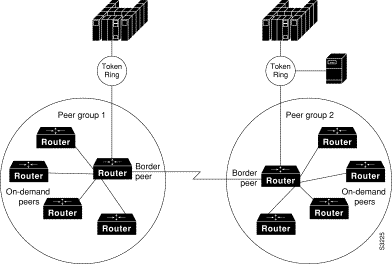
The transport connection between DLSw+ routers can vary according to the needs of the network and is not necessarily tied to TCP/IP as the DLSw standard is. We support three different transport protocols between DLSw+ routers:
DLSw+ offers enhanced availability by maintaining a peer table of multiple paths to a given MAC address or NetBIOS name (where a path is either a remote peer or a local port). Each of our routers maintains a preferred path and one or more capable paths to each destination. The preferred peer is either the peer that responds first to an explorer frame or the peer with the least cost. The preferred port is always the port over which the first positive response to an explorer was received. If the preferred peer to a given destination is unavailable, the next available capable peer is promoted to the new preferred peer. No additional broadcasts are required, and recovery through an alternate peer is immediate.
Maintaining multiple paths per destination is especially attractive in SNA networks. A common technique used in the hierarchical SNA environment is assigning the same MAC address to different Token Ring interface couplers (TICs) on the IBM front-end processors (FEPs). DLSw+ ensures that duplicate TIC addresses are found, and if multiple DLSw+ peers can be used to reach the FEPs, they are all cached.
The way that multiple capable peers are handled with DLSw+ can be biased to meet either of the following network needs:
Figure 26-2 shows a peer table of preferred (Pref) and capable (Cap) routes.
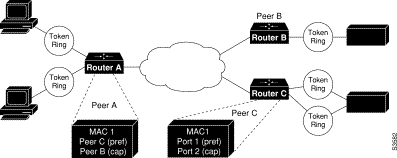
DLSw+ supports media conversion between local or remote LANs and SDLC or Ethernet. For clarity, the configuration task list below describes configuration in a Token Ring environment. The only differences for SDLC and Ethernet are the specific commands needed to configure those media, plus a media-specific command to associate the interface with DLSw+.
To configure DLSw+, perform tasks in the following sections:
See the end of this chapter for "DLSw+ Configuration Examples." Media-specific configuration examples for Ethernet and SDLC are also provided. For details of SDLC commands in the sample SDLC configuration, refer to the "LLC2 and SDLC Commands" chapter of the Router Products Command Reference publication.
The source-bridge ring can be shared between DLSw+ and SRB/RSRB. In DLSw+, the source-bridge ring group specifies the virtual ring that will appear to be the last ring in the RIF. Because RIFs are terminated at the router, there is no correlation between the ring-group number specified in DLSw+ peers. They can be the same for management simplicity, but they do not have to be. To define a source-bridge ring group for DLSw+, perform the following task in global configuration mode:
| Task | Command |
|---|---|
| Define a ring group. | source-bridge ring-group ring-group1 |
Refer to "DLSw+ Using TCP Encapsulation and LLC2 Local AcknowledgmentBasic Configuration Example" for a sample configuration file.
Defining a DLSw+ local peer for a router enables DLSw+. You specify all local DLSw+ parameters as part of the local peer definition. To define a local peer, perform the following task in global configuration mode:
| Task | Command |
|---|---|
| Define the DLSw+ local peer. | dlsw local-peer [peer-id ip-address] [group group] [border] [cost cost] [lf size] [keepalive seconds] [passive] [promiscuous] |
Refer to "DLSw+ Using TCP Encapsulation and LLC2 Local AcknowledgmentBasic Configuration Example" for a sample configuration.
DLSw+ ring lists are used to map traffic on a local interface to remote peers. You can create a ring list of local ring numbers and apply the list to remote peer definitions. Traffic received from a remote peer is only forwarded to the rings specified in the ring list. Traffic received from a local interface is only forwarded to peers if the input ring number appears in the ring list applied to the remote peer definition. The definition of a ring list is optional. If you want all peers and all rings to receive all traffic, you do not have to define a ring list. Simply specify 0 for the list number in the remote peer statement.
To define a ring list, perform the following task in global configuration mode:
| Task | Command |
|---|---|
| Define a ring list. | dlsw ring-list list-number rings ring-number |
DLSw+ port lists are used to map traffic on a local interface (either Token Ring or serial) to remote peers. You can create a port list of local ports and apply the list to remote peer definitions. Traffic received from a remote peer is only forwarded to peers if the input port number appears in the port list applied to the remote peer definition. The port list command provides a single command to specify both serial and Token Ring interfaces. Figure 26-3 shows how port lists are used to map traffic.
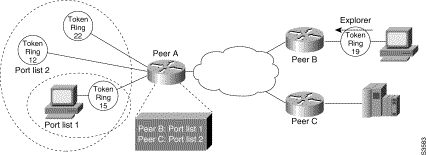
The definition of a port list is optional. If you want all peers and all interfaces to receive all traffic, you do not have to define a port list. Simply specify 0 for the list number in the remote peer statement.
To define a port list, perform the following task in global configuration mode:
| Task | Command |
|---|---|
| Define a port list. | dlsw port-list list-number [serial | tokenring] number [serial | tokenring] number ... |
DLSw+ bridge group lists are used to map traffic on the local Ethernet bridge group interface to remote peers. You can create a bridge group list and apply the list to remote peer definitions. Traffic received from a remote peer is only forwarded to the bridge group specified in the bridge group list. Traffic received from a local interface is only forwarded to peers if the input bridge group number appears in the bridge group list applied to the remote peer definition. The definition of a bridge group list is optional. Because each remote peer has a single list number associated with it, if you want traffic to go to a bridge group and to either a ring list or port list, you should specify the same list number in each definition.
| Task | Command |
|---|---|
| Define a ring list. | dlsw bgroup-list list-number bgroups number |
You can define direct, FST, or TCP encapsulation remote peers by performing one of the following tasks in global configuration mode:
The following is a list of valid port numbers used for TCP connections when the priority keyword is used with the dlsw remote-peer command:
| high | 2065 |
| medium | 1981 |
| normal | 1982 |
| low | 1983 |
Refer to "DLSw+ Using TCP Encapsulation and LLC2 Local AcknowledgmentBasic Configuration Example" for an example DLSw+ configuration for TCP encapsulation.
You can configure the router for direct encapsulation of DLSw+ in Frame Relay according to RFC 1490. DLSw+ Direct over RFC 1490 supports either passthrough or local acknowledgment (DLC termination). DLSw+ supports transport for both SNA and NetBIOS data. SNA PU 2.0 and PU 2.1 are supported.
The media on either end must be Token Ring.
The solution requires a minimum number of PVCs (since multiple protocols can share a single PVC). This simplifies configuration because multiple PUs can share a PVC without requiring configuration of multiple SAPs.
The passthrough option adds the smallest amount of link overhead and requires minimal processing cycles in the attaching routers when compared to TCP/IP encapsulation.
The local acknowledgment option prevents DLC timeouts during periods of WAN congestion. It also minimizes WAN traffic by keeping data link control (DLC) acknowledgments and keepalives off the WAN.
No controller or FEP upgrades are required to take advantage of this feature (if already Token Ring attached), reducing costs and simplifying migration to Frame Relay.
To enable DLSw+ over Frame Relay with passthrough, perform the following tasks, beginning in global configuration mode:
| Task | Command |
|---|---|
| Specify the serial port. | interface serial number 1 |
| Enable Frame Relay encapsulation. | encapsulation frame-relay2 |
| Define the mapping between DLSw+ and the DLCI. | frame-relay map dlsw dlci-number2 |
To enable DLSw+ over Frame Relay with local acknowledgment, perform the following tasks, beginning in global configuration mode:
| Task | Command |
|---|---|
| Specify the serial port. | interface serial number 1 |
| Enable Frame Relay encapsulation. | encapsulation frame-relay2 |
| Define the mapping between DLSw+ and the DLCI. | frame-relay map llc2 dlci-number2 |
To configure peer-on-demand defaults, perform one of the following task in global configuration mode:
To reduce explorer traffic destined for this peer, the peer can send other peers a list of resources for which it has information (icanreach) or does not have information (icannotreach). This information is exchanged as part of a capabilities exchange.To configure static resources that will be exchanged as part of a capabilities exchange, perform one of the following tasks in global configuration mode:
To configure static paths to minimize explorer traffic originating in this peer, perform one of the following tasks in global configuration mode:
To configure duplicate path handling, perform the following task in global configuration mode:
| Task | Command |
|---|---|
| Configure duplicate path handling. | dlsw duplicate-path-bias [load-balance] |
To enable DLSw+ on a Token Ring interface, perform the following task in interface configuration mode:
| Task | Command |
|---|---|
| Enable DLSw+ on a Token Ring interface. | source-bridge local-ring bridge-number ring-group1 |
To enable DLSw+ on certain Ethernet interfaces, perform the following task in global configuration mode:
| Task | Command |
|---|---|
| Enable DLSw+ on an Ethernet interface. | dlsw bridge-group group-number |
To enable DLSw+ on an SDLC interface, perform the following task in interface configuration mode:
| Task | Command |
|---|---|
| Enable DLSw+ on an SDLC interface. | sdlc dlsw sdlc-address |
You can configure DLSw+ for QLLC connectivity, which enables both of the following two scenarios:
To enable QLLC connectivity for DLSw+, perform the following tasks in interface configuration mode:
| Task | Command |
|---|---|
| Specify an interface as an X.25 device. | encapsulation x.251 |
| Activate X.25 subaddresses. | x25 address subaddress1 |
| Associate a virtual MAC address with the X.121 address of the remote X.25 device. | x25 map qllc x121-addr [x25-map-options]2 |
| Enable DLSw+ over QLLC. | qllc dlsw {subaddress subaddress} | {pvc pvc-low [pvc-high]} [vmac vmacaddr [poolsize]] [partner partner macaddr] [sap ssap dsap] [xid xidstring] [npsi-poll]3 |
To modify an existing configuration parameter, perform one or more of the following tasks in global configuration mode:
To monitor and maintain activity on the DLSw+ network, perform one or more of the following tasks in privileged EXEC mode:
The following sections provide DLSw+ configuration examples:
This sample configuration requires the following tasks, which are described in earlier sections of this document:
Encapsulate the source-route bridged traffic inside IP datagrams passed over a TCP connection between two routers/bridges with local acknowledgment enabled when you have LANs separated by wide geographic distances, and you want to avoid multiple retransmissions or loss of user sessions that can occur with time delays.
Logical Link Control-Type 2 (LLC2) is an ISO standard data link level protocol used in Token Ring networks. LLC2 was designed to ensure reliable transmission of data across LAN media with minimal or predictable time delays. With the advent of DLSw+ and WAN backbones, LANs are now separated by wide, geographic distances spanning countries and continents. As a result, these LANs have time delays that are longer than LLC2 allows for bidirectional communication between hosts. The local acknowledgment capability in routers and bridges supporting remote source-route bridging addresses the problem of unpredictable time delays, multiple retransmissions, and loss of user sessions.
In a typical LLC2 session, when one host sends a frame to another host, the sending host expects the receiving host to respond positively or negatively in a predefined period of time commonly called the T1 time. If the sending host does not receive an acknowledgment of the frame it sent within the T1 time, it retries a few times (normally 8 to 10). If there is still no response, the sending host drops the session.
Figure 26-4 illustrates an LLC2 session. A 37x5 on a LAN segment can communicate with a 3x74 on a different LAN segment separated via a wide-area backbone network. Frames are transported between Router A and Router B by means of DLSw+. However, the LLC2 session between the 37x5 and the 3x74 is still end-to-end; that is, every frame generated by the 37x5 traverses the backbone network to the 3x74, and the 3x74, on receipt of the frame, acknowledges it.
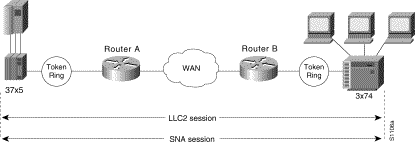
On backbone networks consisting of slow serial links, the T1 timer on end hosts could expire before the frames have a chance to reach the remote hosts, causing the end host to retransmit. This results in duplicate frames reaching the remote host at the same time as the first frame also reached the remote host, albeit slowly. These frame duplications break the LLC2 protocol, resulting in the loss of sessions between the two IBM machines.
One way to solve this time delay problem is to increase the timeout value on the end nodes to account for the maximum transit time between the two end machines. However, in networks consisting of hundreds or even thousands of nodes, every machine would need to be reconfigured with new values. With local acknowledgment for LLC2 turned on, the LLC2 session between the two end nodes would not be end-to-end, but instead, terminate at two local routers. Figure 26-5 shows the LLC2 session with the 37x5 ending at Router A and the LLC2 session with the 3x74 ending at Router B. Both Router A and Router B execute the full LLC2 protocol as part of local acknowledgment for LLC2.

With local acknowledgment for LLC2 enabled in both routers, Router A acknowledges frames received from the 37x5. The 37x5 still recognizes the acknowledgments it receives as belonging to the 3x74. Router A looks like the 3x74 to the 37x5. Similarly, Router B acknowledges frames received from the 3x74. The 3x74 recognizes the acknowledgments it receives as coming from the 37x5. Router B looks like the 3x74 to 37x5. Because the frames no longer have to travel the WAN backbone networks to be acknowledged, but instead are locally acknowledged by routers, the end machines do not time out, resulting in no loss of sessions.
The advantages of enabling local acknowledgment for LLC2 include the following:
LLC2 local acknowledgment is enabled only with TCP remote peers (as opposed to LAN or direct serial interface remote peers).
If the LLC2 session between the local host and the router terminates in either router, the other will be informed to terminate its connection to its local host.
If the TCP queue length of the connection between the two routers reaches the highwater mark, the routers sends Receiver-Not-Ready (RNR) messages to the local hosts until the queue limit is reduced to below this limit.
The configuration of the LLC2 parameters for the local Token Ring interfaces can affect overall performance. Refer to the chapter "Configuring LLC2 and SDLC Parameters" in this manual for more details about fine-tuning your network through the LLC2 parameters.
The routers at each end of the LLC2 session execute the full LLC2 protocol, which could result in some overhead. The decision to use local acknowledgment for LLC2 should be based on the speed of the backbone network in relation to the Token Ring speed. For LAN segments separated by slow-speed serial links (for example, 56 kbps), the T1 timer problem could occur more frequently. In such cases, it might be wise to turn on local acknowledgment for LLC2. For LAN segments separated by a T1, backbone delays will be minimal; in such cases, FST or direct should be used. Speed mismatch between the LAN segments and the backbone network is one criterion to help you decide to use local acknowledgment for LLC2.
There are some situations (such as the receiving host failing between the time the sending host sends data and the time the receiving host receives it), in which the sending host would determine, at the LLC2 layer, that data was received when it actually was not. This error occurs because the router acknowledges that it received data from the sending host before it determines that the receiving host can actually receive the data. But because both NetBIOS and SNA have error recovery in situations where an end device goes down, these higher-level protocols will resend any missing or lost data. Because these transaction request/confirmation protocols exist above LLC2, they are not affected by tight timers, as is LLC2. They also are transparent to local acknowledgment.
If you are using NetBIOS applications, note that there are two NetBIOS timers--one at the link level and one at the next higher level. Local acknowledgment for LLC2 is designed to solve link timeouts only. If you are experiencing NetBIOS session timeouts, you have two options:
Figure 26-6 illustrates a DLSw+ configuration with local acknowledgment.

source-bridge ring-group 10 ! dlsw local-peer peer-id 10.2.25.1 dlsw remote-peer 0 tcp 10.2.5.2 int loopback 0 ip address 10.2.25.1 255.255.255.0 . . . interface TokenRing 0 no ip address ring-speed 16 source-bridge active 25 1 10
source-bridge ring-group 12 dlsw local-peer peer-id 10.2.5.2 dlsw remote-peer 0 tcp 10.2.25.1 int loopback 0 ip address 10.2.5.2 255.255.255.0 . . . interface TokenRing 0 no ip address ring-speed 16 source-bridge active 5 1 12
Figure 26-7 illustrates DLSw+ configured using border peers, showing circuits to each other. Router A is configured to operate in promiscuous mode, and border peers Routers B and C forward broadcasts. This configuration reduces processing requirements in Router A (the access router) and still support any-to-any networks.

The following are configuration files for the routers in Figure 6.
hostname RouterA ! source-bridge ring group 31 dlsw local-peer peer-id 128.207.152.5 group 70 promiscuous dlsw remote peer 0 tcp 128.207.150.8 ! interface Serial0 ip unnumbered TokenRing clockrate 56000 ! interface TokenRing 0 ip address 128.207.152.5 255.255.255.0 ring-speed 16 source-bridge 200 13 31 source-bridge spanning ! . . . router igrp 777 network 128.207.0.0
hostname RouterB ! . . . source-bridge ring-group 31 dlsw local-peer peer-id 128.207.150.8 group 70 border promiscuous dlsw remote-peer 0 tcp 128.207.169.3 dlsw remote-peer 0 tcp 128.207.152.5 ! . . . interface serial0 ip unnumbered tokenring 0 bandwidth 56 ! . . . interface tokenring 0 ip address 128.207.150.8 255.255.255.0 ring-speed 16 source-bridge 3 14 31 source-bridge spanning ! router igrp 777 network 128.207.0.0
hostname RouterC ! . . . source-bridge ring-group 69 dlsw local-peer peer-id 128.207.169.3 group 69 border promiscuous dlsw remote-peer 0 tcp 128.207.150.8 ! . . . interface tokenring 3/0 description fixed to flashnet ip address 128.207.2.152 255.255.255.0 ring-speed 16 multiring all ! interface tokenring 3/1 ip address 128.207.169.3 255.255.255.0 ring-speed 16 source-bridge 33 2 69 source-bridge spanning ! . . . router igrp 777 network 128.207.0.0
Figure 26-8 illustrates a peer group configuration that allows any-to-any connection except for Router B.
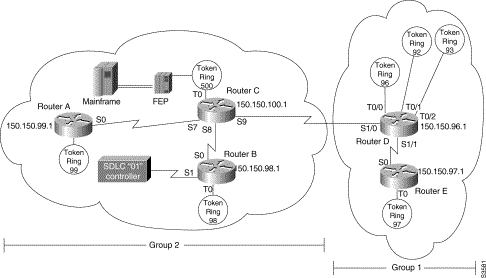
The following are configuration files for the routers in Figure 26-8:
hostname Router A ! . . . source-bridge ring-group 2000 dlsw local-peer peer-id 150.150.99.1 dlsw remote-peer 0 tcp 150.150.100.1 ! interface loopback 0 ip address 150.150.99.1 255.255.255.192 ! interface serial 0 ip address 150.150.9.1 255.255.255.192 ! . . . interface tokenring 0 no ip address ring-speed 16 source-bridge 99 1 2000 source-bridge spanning ! . . . router eigrp 202 network 150.150.0.0
hostname RouterB ! . . . source-bridge ring-group 2000 dlsw local-peer peer-id 150.150.98.1 group 2 dlsw remote-peer 0 tcp 150.150.100.1 ! interface loopback 0 ip address 150.150.98.1 255.255.255.192 ! . . . interface serial 1 no ip address encapsulation sdlc no keepalive priority-group 1 clockrate 9600 sdlc role primary sdlc vmac 4000.8888.0100 sdlc address 01 sdlc xid 01 05d20006 sdlc partner 4000.1020.1000 01 sdlc dlsw 1 ! interface tokenring 0 no ip address ring-speed 16 multiring all source-bridge 98 1 2000 source-bridge spanning ! . . . router eigrp 202 network 150.150.0.0
hostname RouterC ! . . . source-bridge ring-group 2000 dlsw local-peer peer-id 150.150.100.1 group 2 border promiscuous dlsw remote-peer 0 tcp 150.150.96.1 dlsw remote-peer 0 tcp 150.150.98.1 dlsw remote-peer 0 tcp 150.150.99.1 ! interface loopback 0 ip address 150.150.100.1 255.255.255.192 ! . . . interface serial 7 ip address 150.150.9.2 255.255.255.192 clockrate 56000 ! interface serial 8 ip address 150.150.10.2 255.255.255.192 ! interface serial 9 ip address 150.150.8.2 255.255.255.192 ! interface tokenring 0 no ip address ring-speed 16 multiring all source-bridge 500 1 2000 ! router eigrp 202 network 150.150.0.0
hostname RouterD ! . . . source-bridge ring-group 2000 dlsw local-peer peer-id 150.150.96.1 group 1 border dlsw remote-peer 0 tcp 150.150.97.1 dlsw remote-peer 0 tcp 150.150.100.1 ! interface loopback 0 ip address 150.150.96.1 255.255.255.192 ! . . . interface serial 1/0 ip address 150.150.8.1 255.255.255.192 clockrate 56000 ! interface serial 1/1 ip address 150.150.16.1 255.255.255.192 ! . . . interface tokenring g0/0 ip address 150.150.2.1 255.255.255.192 ring-speed 16 source-bridge 96 1 2000 source-bridge spanning ! interface tokenring 0/1 ip address 150.150.13.1 255.255.255.192 no ip address ring-speed 16 source-bridge 92 1 2000 source-bridge spanning ! . . . router eigrp 202 network 150.150.0.0
hostname RouterE ! . . . source-bridge ring-group 2000 dlsw local-peer peer-id 150.150.97.1 group 1 promiscuous dlsw remote-peer 0 tcp 150.150.96.1 ! interface loopback 0 ip address 150.150.97.1 255.255.255.192 ! interface serial 0 mtu 1400 ip address 150.150.16.2 255.255.255.192 ! . . . interface tokenring 0 no ip address no ip route-cache ring-speed 16 source-bridge 97 1 2000 source-bridge spanning ! . . . router eigrp 202 network 150.150.0.0
DLSw+ also supports Ethernet media. Except for configuring for a specific media, in this case Ethernet, the configuration is similar to other DLSw+ configuration (see Figure 26-9).
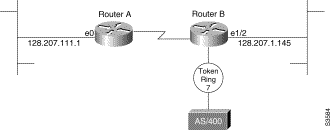
The following are the configuration files for the routers in Figure 26-9.
hostname RouterA ! . . . source-bridge ring-group 31 dlsw local-peer peer-id 128.207.111.1 dlsw remote-peer 0 tcp 128.207.1.145 lf 1500 dlsw bridge-group 5 ! interface Ethernet 0 ip address 128.207.111.1 255.255.255.0 bridge-group 5 ! . . bridge 5 protocol ieee ! . .
hostname RouterB ! . . . source-bridge ring-group 500 dlsw local-peer peer-id 128.207.1.145 dlsw remote-peer 0 tcp 128.207.111.1 lf 1500 dlsw bridge-group 5 . . . interface ethernet 1/2 ip address 128.207.1.145 255.255.255.0 bridge-group 5 . . . interface tokenring 2/0 no ip address ring-speed 16 multiring all source-bridge 7 1 500 source-bridge spanning ! . . . router igrp 777 network 128.207.0.0
DLSw+ provides media conversion between local or remote LANs and SDLC. For additional information about configuring SDLC parameters, refer to the chapter "Configuring LLC2 and SDLC Parameters."
Figure 26-10 illustrates DLSw+ with SDLC encapsulation. For this example, 4000.1020.1000 is the MAC address of the FEP host (PU4). 1000.5aed.1f53 is the MAC address of the AS/400 host, which is defined as Node Type 2.1. Router B serves as the primary station for the remote secondary stations 01. Router B can serve as either primary station or secondary station to remote station D2.
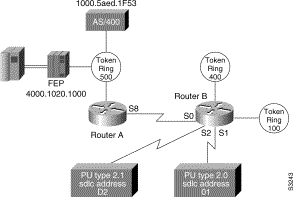
The following is the configuration file for Router A:
hostname RouterA ! . . . source-bridge ring-group 2000 dlsw local-peer peer-ed 150.150.10.2 dlsw remote-peer 0 tcp 150.150.10.1 ! . . . interface serial 8 ip address 150.150.10.2 255.255.255.192 clockrate 56000 ! . . . interface tokenring 0 no ip address ring-speed 16 source-bridge 500 1 2000 source-bridge spanning ! . . . router eigrp 202 network 150.150.0.0
hostname RouterB ! . . . source-bridge ring-group 2000 dlsw local-peer peer-id 150.150.10.1 dlsw remote-peer 0 tcp 150.150.10.2 ! . . . interface serial 0 ip address 150.150.10.1 255.255.255.192 ! interface serial 1 description PU2 with SDLC station role set to secondary no ip address encapsulation sdlc no keepalive clockrate 9600 sdlc role primary sdlc vmac 4000.9999.0100 sdlc address 01 sdlc xid 01 05d20006 sdlc partner 4000.1020.1000 01 sdlc dlsw 1 ! interface serial 2 description Node Type 2.1 with SDLC station role set to negotiable or primary encapsulation sdlc sdlc role none sdlc vmac 1234.3174.0000 sdlc address d2 sdlc partner 1000.5aed.1f53 d2 sdlc dlsw d2 ! interface tokenring 0 no ip address early-token-release ring-speed 16 multiring all source-bridge 100 1 2000 source-bridge spanning ! interface tokenring 1 no ip address ring-speed 16 multiring all source-bridge 400 1 2000 source-bridge spanning ! router eigrp 202 network 150.150.0.0
Frame Relay support extends the DLSw+ capabilities to include Frame Relay in direct mode. Frame Relay support includes permanent virtual circuit capability and provides a newly supported DLC. DLSw+ runs over Frame Relay without LACK. It supports the Token Ring-to-Token Ring connections similar to FST and other direct DLCs. Figure 26-11 illustrates a DLSw+ configuration over Frame Relay.

The following configuration examples are based on Figure 26-11. The Token Rings in the illustration are Ring 2.
source-bridge ring-group 100 dlsw local-peer peer-id 1.1.1.1 dlsw remote-peer 0 frame-relay interface 0 30 ! interface tokenring 0 ring-speed 16 source-bridge active 1 1 100 ! interface serial 0 mtu 3000 no ip address encapsulation frame-relay frame-relay lmi-type ansi frame-relay map llc2 30
source-bridge ring-group 100 dlsw local-peer peer-id 1.1.1.2 dlsw remote-peer 0 frame-relay interface 0 30 ! interface tokenring 0 ring-speed 16 source-bridge active 2 1 100 ! interface serial 0 mtu 3000 no ip address encapsulation frame-relay frame-relay lmi-type ansi frame-relay map llc2 30
The following three examples describe QLLC support for DLSw+.
In this configuration, DLSw+ is used to allow remote devices to connect to a DLSw+ network over an X.25 public packet-switched network.
In this example, all QLLC traffic is addressed to destination address 4000.1161.1234, which is the MAC address of the FEP.
The remote X.25-attached 3174 is given a virtual MAC address of 1000.0000.0001. This virtual MAC address is mapped to the X.121 address of the 3174 (31104150101) in the X.25 attached router.
interface serial 0 encapsulation x25 x25 address 3110212011 x25 map qllc 1000.0000.0001 31104150101 qllc dlsw partner 4000.1611.1234
In this configuration, a single 3174 needs to communicate with both an AS/400 and a FEP. The FEP is associated with subaddress 150101 and the AS/400 is associated with subaddress 151102.
If an X.25 call comes in for 33204150101, the call is mapped to the FEP and forwarded to mac address 4000.1161.1234. The 3174 appears to the FEP as a Token Ring-attached resource with MAC address 1000.0000.0001. The 3174 uses a source SAP of 04 when communicating with the FEP, and a source SAP of 08 when communicating with the AS/400.
interface serial 0 encapsulation x25 x25 address 31102 x25 map qllc 1000.0000.0001 33204 qllc dlsw subaddress 150101 partner 4000.1161.1234 qllc dlsw subaddress 150102 partner 4000.2034.5678 sap 04 08
In this example, two different X.25 resources want to communicate over X.25 to the same FEP.
In the router attached to the X.25 network, every X.25 connection request for X.121 address 31102150101 is directed to DLSw+. The first SVC to be established will be mapped to virtual MAC address 1000.0000.0001. The second SVC to be established will be mapped to virtual MAC address 1000.0000.0002.
interface serial 0 encapsulation x25 x25 address 31102 x25 map qllc 33204 x25 map qllc 35765 qllc dlsw subaddress 150101 vmacaddr 1000.0000.0001 2 partner 4000.1611,1234
|
|